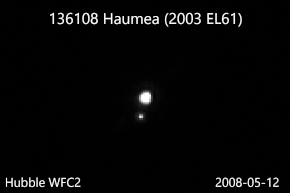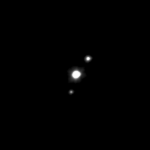Hiʻiaka (moon)
 In this series of photos taken by the Hubble Space Telescope, the brighter object Hiʻiaka is seen orbiting Haumea (center). | |
| Discovery | |
|---|---|
| Discovered by | Michael E. Brown, Chad Trujillo, David Rabinowitz, et al. |
| Discovery date | 26 January 2005 |
| Designations | |
Designation | Haumea I (136108) Haumea I Hiʻiaka |
| Pronunciation | /hiːʔiˈɑːkə/ Hawaiian: [ˈhiʔiˈjɐkə] |
| (136108) 2003 EL61 I S/2005 (2003 EL61) 1 | |
| Orbital characteristics[1] | |
| 49880±198 km | |
| Eccentricity | 0.0513±0.0078 |
| 49.12±0.03 d | |
| 152.8°±6.1° | |
| Inclination | 126.356±0.064° |
| 206.766°±0.033° | |
| 154.1°±5.8° | |
| Satellite of | Haumea |
| Physical characteristics | |
| ~160 km[1] | |
| Mass | (1.79±0.11)×1019 kg[1] (0.45% of Haumea) |
Mean density | ~1 g/cm3 |
| ~9.8 h[2] | |
| Albedo | 0.8±0.07[3][1] |
| Temperature | 32±3 K |
| 20.3 (3.0 difference from primary's 17.3)[3] | |
Hiʻiaka is the larger, outer moon of the trans-Neptunian dwarf planet Haumea. It is named after one of the daughters of Haumea, Hiʻiaka, the patron goddess of the Big Island of Hawaii. It orbits once every 49.12±0.03 d at a distance of 49880±198 km, with an eccentricity of 0.0513±0.0078 and an inclination of 126.356±0.064°. Assuming its estimated diameter of over 300 km is accurate, it may be the fourth- or fifth-largest known moon of a Trans-Neptunian object, after Pluto I Charon, Eris I Dysnomia, Orcus I Vanth, and possibly Varda I Ilmarë and Salacia I Actaea.
Discovery
[edit]Hiʻiaka was the first satellite discovered around Haumea. It was discovered on 26 January 2005 and nicknamed "Rudolph" by the discovery team before being assigned an official name.[citation needed]
Physical characteristics
[edit]Size and brightness
[edit]Its measured brightness is 5.9±0.5%, translating into a diameter of about 22% of its primary, or in the range of 320 km, assuming similar infrared albedo.[1] To put this in perspective, if Hiʻiaka were in the asteroid belt, it would be larger than all but the four largest asteroids, after 1 Ceres, 2 Pallas, 4 Vesta, and 10 Hygiea. In spite of its relatively large size, however, lightcurve studies suggest that Hiʻiaka is not a gravitationally collapsed spheroid; they further suggest that Hiʻiaka is not tidally locked and has a rotation period of about 9.8 hours.[2]
Mass
[edit]The mass of Hiʻiaka is estimated to be (1.79±0.11)×1019 kg using precise relative astrometry from the Hubble Space Telescope and Keck Telescope and applying 3-body, point-mass model to the Haumean system.[1]
Spectrum and composition
[edit]The near infrared spectrum of Hiʻiaka is dominated by water-ice absorption bands, which means that its surface is made mainly of water ice. The presence of the band centered at 1.65 μm indicates that the surface water ice is primarily in the crystalline form. Currently it is unclear why water ice on the surface has not turned into amorphous form as would be expected due to its constant irradiation by cosmic rays.[4]
See also
[edit]- Namaka, the other moon of Haumea
References
[edit]- ^ a b c d e f Ragozzine, D.; Brown, M. E. (2009). "Orbits and Masses of the Satellites of the Dwarf Planet Haumea (2003 EL61)". The Astronomical Journal. 137 (6): 4766–4776. arXiv:0903.4213. Bibcode:2009AJ....137.4766R. doi:10.1088/0004-6256/137/6/4766. S2CID 15310444.
- ^ a b Hastings, Danielle M.; Ragozzine, Darin; Fabrycky, Daniel C.; Burkhart, Luke D.; Fuentes, Cesar; Margot, Jean-Luc; Brown, Michael E.; Holman, Matthew (December 2016). "The Short Rotation Period of Hiʻiaka, Haumea's Largest Satellite". The Astronomical Journal. 152 (6): 12. arXiv:1610.04305. Bibcode:2016AJ....152..195H. doi:10.3847/0004-6256/152/6/195. OCLC 6889796157. OSTI 22662917. S2CID 33292771. 195.
- ^ a b Wm. Robert Johnston (17 September 2008). "(136108) Haumea, Hiʻiaka, and Nāmaka". Archived from the original on 21 December 2017. Retrieved 18 September 2008.
- ^ Dumas, C.; Carry, B.; Hestroffer, D.; Merlin, F. (2011). "High-contrast observations of (136108) Haumea". Astronomy & Astrophysics. 528: A105. arXiv:1101.2102. Bibcode:2011A&A...528A.105D. doi:10.1051/0004-6361/201015011. S2CID 119226136.



